|
[For the
uninitiated, a 'blog' (or weblog)
is a web journal with links. This gives me a chance to add short, 'off the record' style items that
wouldn't merit a separate article. I try my best to keep entries informal,
frequent, brief and (hopefully) interesting. For more information
about Jamie Goode, see the about the author
section. ]
Sunday
18th September
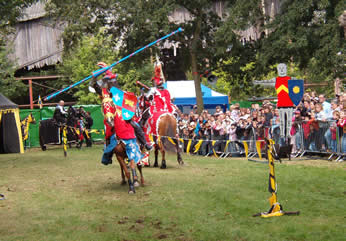 Youngest
son's 8th birthday was the cause for a weekend spent at Legoland. Of
all the theme parks (and I've done a lot of theme parks in the
last few years) Legoland is the favourite, chiefly for its nice family
atmosphere and inspired sense of imagination. Still, you need to be in
your most child-centred, reconstructed noughties dad mode to survive
this odd sort of parallel reality. We took the kids on a special deal
which included a hotel stay (even though we are in very easy - 20
minutes -driving distance of Legoland) and two days in the park for a
very reasonable price. On Saturday we were accompanied by good friends
with kids of the same age; they were wise, and didn't join us on
Sunday. One of the special attractions was a jousting tournament
(pictured). I'm really pleased that our kids, who are worryingly like
teenagers in their attitude at times, seemed to get caught up in some
of the childhood wonder and innocent enjoyment that they used to show
before they grew up too fast and caught their inner-city attitude. I
know I sound like an old fart, but these days kids are pressured to
grow up too fast; childhood is precious and there's no need to leave
behind it in a rush. Where did my lovely little boys go? Soon they
won't want a cuddle and they'll not want to play with me all
the time. I'll miss it. Youngest
son's 8th birthday was the cause for a weekend spent at Legoland. Of
all the theme parks (and I've done a lot of theme parks in the
last few years) Legoland is the favourite, chiefly for its nice family
atmosphere and inspired sense of imagination. Still, you need to be in
your most child-centred, reconstructed noughties dad mode to survive
this odd sort of parallel reality. We took the kids on a special deal
which included a hotel stay (even though we are in very easy - 20
minutes -driving distance of Legoland) and two days in the park for a
very reasonable price. On Saturday we were accompanied by good friends
with kids of the same age; they were wise, and didn't join us on
Sunday. One of the special attractions was a jousting tournament
(pictured). I'm really pleased that our kids, who are worryingly like
teenagers in their attitude at times, seemed to get caught up in some
of the childhood wonder and innocent enjoyment that they used to show
before they grew up too fast and caught their inner-city attitude. I
know I sound like an old fart, but these days kids are pressured to
grow up too fast; childhood is precious and there's no need to leave
behind it in a rush. Where did my lovely little boys go? Soon they
won't want a cuddle and they'll not want to play with me all
the time. I'll miss it.
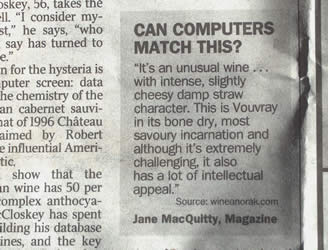 Some
other good friends of ours dug out an interesting cutting from The
Times in late August. An article
on Enologix, it quoted one of my tasting notes (right). But
what was most perplexing is that it was credited to Jane MacQuitty
(even more strikingly on the web edition). That's unfair; she doesn't
write notes like this. I wrote it. Why should she get the credit for
it? [In fact, I suspect the intention of the author was to poke fun at
it. He likely found it on a trawl through the web (which is where most
journalists do their research these days), where this very note has
been quoted before in a derisory way.] I stand by the language used
here. The strictly analytical tasting note is next to worthless. We
need to use more imaginative ways to convey our own private perceptual
experiences than lists of fruits and spices. Some
other good friends of ours dug out an interesting cutting from The
Times in late August. An article
on Enologix, it quoted one of my tasting notes (right). But
what was most perplexing is that it was credited to Jane MacQuitty
(even more strikingly on the web edition). That's unfair; she doesn't
write notes like this. I wrote it. Why should she get the credit for
it? [In fact, I suspect the intention of the author was to poke fun at
it. He likely found it on a trawl through the web (which is where most
journalists do their research these days), where this very note has
been quoted before in a derisory way.] I stand by the language used
here. The strictly analytical tasting note is next to worthless. We
need to use more imaginative ways to convey our own private perceptual
experiences than lists of fruits and spices.
Thursday
15th September
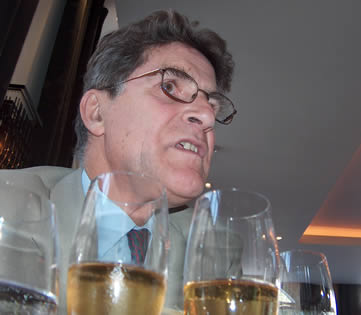 Two
rather good lunches yesterday and today. On Wednesday it was time for
some Krug, with Rťmi himself (pictured) at The
Ledbury. We kicked off with a glass of Krug Grande Cuvťe,
which was complex, fresh, fruity and showing a distinctive herbal
edge. This was followed with three fantastic vintage wines, the 88, 89
and 90. Itís rare (almost unheard of) to have three vintages
released in a row. Theyíre all fantastic, and quite different in
personality. The 88 is more savoury: itís concentrated and quite
acidic with a really solid personality. The 1989 is quite different.
Itís sweetly fruited, honeyed and spicy with an amazing perfume. The
1990 is tighter and potentially longer lived Ė a bit like a
combination of the 88 and 89 but with another dimension altogether.
This will show brilliantly in 20 years. The Ledbury (just north of
Notting Hill tube) is a superb restaurant, and on this showing is
worth a couple of Michelin stars. If anything, it outshone my
experience at Le Gavroche the previous evening. Two
rather good lunches yesterday and today. On Wednesday it was time for
some Krug, with Rťmi himself (pictured) at The
Ledbury. We kicked off with a glass of Krug Grande Cuvťe,
which was complex, fresh, fruity and showing a distinctive herbal
edge. This was followed with three fantastic vintage wines, the 88, 89
and 90. Itís rare (almost unheard of) to have three vintages
released in a row. Theyíre all fantastic, and quite different in
personality. The 88 is more savoury: itís concentrated and quite
acidic with a really solid personality. The 1989 is quite different.
Itís sweetly fruited, honeyed and spicy with an amazing perfume. The
1990 is tighter and potentially longer lived Ė a bit like a
combination of the 88 and 89 but with another dimension altogether.
This will show brilliantly in 20 years. The Ledbury (just north of
Notting Hill tube) is a superb restaurant, and on this showing is
worth a couple of Michelin stars. If anything, it outshone my
experience at Le Gavroche the previous evening.
This morning it was Tescoís press tasting, an
important event in the calendar seeing as 20% of off-trade wine sales
(in volume) go through this supermarket. That is, one in every five
bottles sold in the UK are bought at Tesco. I finished off and headed
over to St
John, for lunch with leading Australian wine writer Max Allen
and his sisterís boyfriend Joe, a chef currently touring round
Europe and the USA, with a view to getting experience of some of the
worldís best restaurants. Itís my third time at St John, but my
first as a paying punter. The lunch was superb: I had cured beef and
celeriac followed by saddle of hare. We washed our food down with two
brilliant northern RhŰnes. First, a vibrantly fruity Fayolle
Crozes Hermitage ĎLes VoussŤresí 2003, showing lovely smooth
structure. Then Vincent Paris St Joseph 2003, which was a step
up, with lovely crunchy, peppery fruit, primary and vivid, dark and
inviting. A delicious fresh, nicely structured wine. Both were just
over £30 on the list. St John is a good experience: it isnít cheap,
but itís good value, and I like the ambience of the dining room,
with its basic, almost stark looks. The professional, unfussy,
unpretentious service is
also appreciated.
Wednesday
14th September
It was
nice for Food and Wine magazine to vote this as one of Seven
Best Wine Blogs. Others have pointed out that technically it
isnít a blog because it doesnít have an RSS feed and space for
comments. This may change: they are features Iím thinking of
implementing, but I want the blog to remain on this server as part of
the wineanorak site, so Iíll have to investigate the likes of Moving
Type.
Last
night was fun. It was a beer and wine matching evening at Le
Gavroche, one of
London
ís top
restaurants. Five journos were present: Jancis Robinson MW and hubbie
Nick Lander, Tim Atkin MW, Peter McCombie MW and myself. Just before I
left a voice in the back of my mind said ĎLe Gavroche: dress
codeí, so I phoned up organizer Rupert Ponsonby to check. ĎOh, no,
Tim will probably come in shortsí. So I turn up there and at the
reception Iím discretely given a jacket to wear. Gentlemen must wear
jackets at all times in the restaurant, as Tim found out when he tried
to take his off after the first course. So I slip on this jacket only
to find out, to my horror, that it has brass buttons. How embarrassing
is that? Well, although Iím not keen on dress codes, itís their
gaff, so Le Gavroche can make their rules. And they were very good
about providing a jacket to the jacketless. What wasnít excusable
was the attitude of the snooty French FOH person (not the main guy,
though) who I walked past on my way to the table. I was carrying my
laptop bag, because this contains my note book and pen. He looks at
me: ĎSir, you are travelling?í in a voice barely disguising his
disdain for the fact that Iím carrying a bag into his precious
restaurant. He then tries to make a joke of it when I explain why. But
it was a comment made to make a customer, already slightly embarrassed
that heís wearing the rear-admiral-of-the-fleetís jacket, feel
small. Anyhow, this aside, the six course meal was very, very good
indeed and the evening opened my eyes to the possibility of matching
beers with wine, something Iíve not really thought about much
before. Besides, eating at the Gavroche is pretty special: it was the
first really famous restaurant in
London
that I ever heard
about, and this was my first time there. Next time Iíll wear my own
clothes. Iím shortly off to the Ledbury for lunch with Remi Krug,
and while I doubt thereís a dress code there, I shall be wearing my
jacket. Tomorrow Iím meeting Aussie wine writer Max Allen at
St John
for lunch. Itís a tough life, but Iíve got the staminaÖjust. I'm
still in reality, despite keeping such illustrious company: it's
nothing to do with me, rather the fact that I have a national column.
Lose that, and I'll quickly be forgotten about, wandering friendless
and alone through the tastings and longing for the days when I could
turn down two press trips a week.
Thursday
8th September
After spending some time tasting Vintage Ports and Douro table wines
from the 2003 vintage, my conclusion is that this is a very good
vintage for the region. While the wines are certainly ripe, I donít
get too much over-ripeness or jamminess in most. I liked almost
everything I tried. The structure seems pretty good in these wines,
unlike in Burgundy and the RhŰne in 2003 where the tannins are very
tight in an unpleasant, astringent fashion in many red wines. Iíve
nothing against structure: red wines need this. Itís just that
thereís good structure and bad structure, and the problem I have is
with what I can only describe of sharp astringency. Iíve yet to try
many 2003 Bordeaux, but Iíll put this right at the forthcoming Union
des Grands Crus tasting. That should prove to be interesting.
2004 should also be an excellent vintage in the Douro,
in a more classic style than 2003. Iím looking forward to these
wines. 2005 is so far looking very difficult. Harvest has just started
here after a long drought. Some of the vineyards are suffering such
bad water stress that the vines are dying. Yields should be down,
perhaps 30%, and potential alcohol should be very high. Some of this
high potential alcohol will be because of dehydration, not ripeness.
Winemakers may have to reach for their hosepipes. On Tuesday night
there was rain; it would have been welcomed earlier Ė coming so
close to the harvest it is a little worrying, but providing conditions
are dry from now on shouldnít cause any problems with rot. In fact,
this rainfall could be valuable because it will stop some of the vines
on the brink from keeling over. All in all, itís been a stressful
growing season for both vines and growers.
Wednesday
7th September
Dirk Niepoort is in town for the New Douro tasting, so on Tuesday
night we have an impromptu dinner at Tendido Cero, the wonderful tapas
joint on the old Brompton Road. After last time's excess, we agree to
keep the bottle count down. We try to do our wines blind but are
thwarted by the fact the staff don't get the concept. Dirk has brought
Chave Hermitage 2001. It's a wine I've been lucky to try a
couple of times previously (once with Dirk at Alvaro
Castro's place in the D„o, May 2004, and once at the famous Grand
Cru Wines Languedoc-Rousillon
versus the classics tasting). It's a stunning wine, showing
complexity, freshness and elegance - as Dirk points out, it's not a
wine many will get, but I love it. It's the most Burgundian of
Northern RhŰnes. I can't think of many better Syrahs. My effort paled
in comparison, but was still surprisingly tasty. It was the 1997
Valbuena from Vega Sicilia. A dodgy vintage, but a wine that is
showing a lot of dense fruit and just a tiny hint of American oak.
It's a pretty good effort. We finished with a half bottle of Zilliken's
Saarburger Rausch Riesling Auslese 1997, which was close to
perfect: focused, piercing, precise. A very enjoyable
evening.
Monday
5th September
So
it's back to school for the kids, and back to work for wine writers.
The new tasting season starts in earnest this week, and for me it
kicked off in style with a tasting of icon wines from South Africa,
held at WOSA's offices in Wimbledon. A great chance to taste some of
the best new wines coming from the Cape, including brilliant whites
and reds from both the Foundry (Syrah and Viognier) and Eben Sadie (Columella
and Palladius). More to come very soon on this.
For the next few weeks you could
be tasting wine full time if you fancied it (and you were high enough
up on the relevant lists to get the invites). This clustering of
tasting is a good idea for out-of-towners, but the drawback is
that if you do two big tastings a day you end up sampling an enormous
amount of wines. And no matter how well trained your palate is, there
are physiological limits to how many wines you can assess in a single
day or session. The problem is that if you do too many wines too
quickly, the exposure to the previous wines alters your perception of
subsequent ones.
I
find that as I'm gaining experience, I can do about 90 to 120 wines in
a day and write something sensible about them, but I have a sneaking
feeling that I perform better if I do fewer. For me, a session with 30
wines, followed by a break, followed by another 30 wines is perfect.
It's the gold standard. 100 wines in a day is OK with a sufficiently
slow pace; too many more is a
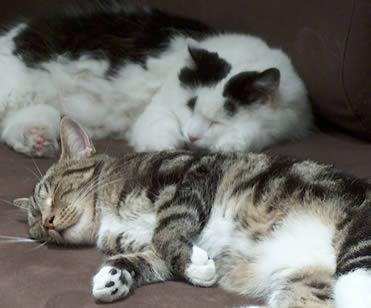 frustrating
waste of effort, I feel. Experience helps counter physiological
limitations, but it doesn't beat them altogether. Red wines do the
worst damage to the palate. I suspect that sometimes the way people
talk about a wine changing over the course of an evening could equally
well be due to the changes to their palate with repeated exposure as
it could be to with changes in the wine upon aeration. frustrating
waste of effort, I feel. Experience helps counter physiological
limitations, but it doesn't beat them altogether. Red wines do the
worst damage to the palate. I suspect that sometimes the way people
talk about a wine changing over the course of an evening could equally
well be due to the changes to their palate with repeated exposure as
it could be to with changes in the wine upon aeration.
Talking
of pace, I think we could learn a few things from cats. We have two of
them, and they have a chilled existence. They eat, sleep, go next door
to eat a bit more, come back in and sleep, go outside to pace around a
bit, come back for more food, sleep a bit, go scavenging and then
sleep some more. Pictured are our two feline housemates last night,
just after it started raining. They are relaxing on the chaise longue,
dreaming of more scrounged dinners and extracurricular strokes. The
one at the back is Oswald, who was once Eric
Clapton's cat; to the fore is young Shrek, who we got as a kitten
a couple of years back.
Saturday
3rd September
We should celebrate excellent performance in any sphere of human
activity. On my doorstep this morning, Corney & Barrow's 05/06
list. It's excellent in so many ways. Firstly, it's beautifully
designed and produced. Secondly, Corney & Barrow have a stunning
roster of exclusivities. The UK has some really good high-end wine
merchants. If I was wealthier, I'd have to live a long time to be
bored by shopping at, say, just Corney & Barrow and Berry Bros
& Rudd. Mainly the work of associate director Alison Buchanan,
this hardback-bound list makes beautiful reading. Particularly
interesting is a full-colour glossy section in the middle entitled
'Back Label', which is in essence a small wine magazine authored by
C&B staff. The contents list reads like a sawn-off version of my
new book (out next month) though, with short features on closures,
biodynamics, terroir, yeasts and oak. What a fantastic idea.
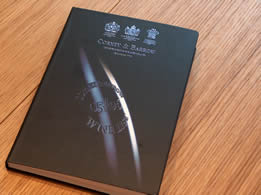 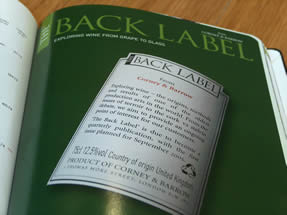
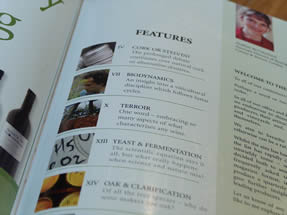 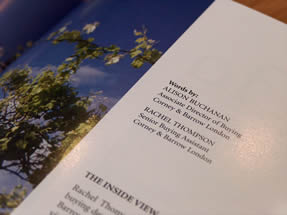
Toady
has been a good day. We lunched at the Half Moon in Windlesham (we
were vaguely sussing the West End/Windlesham area out - it seems a nice place,
if quite a bit further out from London), where I had the mellow
experience of sitting in the sun and drinking two pints of Timothy
Taylor's Landlord. This is a fine ale with a lovely fresh, slightly
bitter hoppy character. It's funny: with beer, I feel less of a need
to constantly be trying something new. Find a great pint like this,
and you can drink it again, again, again. What constitutes excellent
performance? It's hard to define. But when you encounter it, you kind
of just know. And then you sit back, and appreciate it.
I
have now communicated with David Bird, apologizing for not being quite
as kind as I could have been about the design of his book. He
graciously accepted my apology, and told me that Harpers have
asked him to review my book...
Tuedsay
30th August
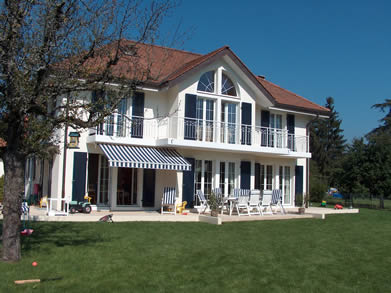 Just back from a fantastic four days in Geneva.
Fionaís brother Cliff lives in a large house (right) in a
rather charming village called Commugny, a short distance along the
south shore of Lac Leman from the city, and he invited his two
sisters, Sandra and Fiona (the one Iím the significant other of) to
bring their families to stay over the August bank holiday. Or did we
invite ourselves? Iím not sure, but I think we will invite ourselves
back again as soon as possible, because we had a brilliant time. Just back from a fantastic four days in Geneva.
Fionaís brother Cliff lives in a large house (right) in a
rather charming village called Commugny, a short distance along the
south shore of Lac Leman from the city, and he invited his two
sisters, Sandra and Fiona (the one Iím the significant other of) to
bring their families to stay over the August bank holiday. Or did we
invite ourselves? Iím not sure, but I think we will invite ourselves
back again as soon as possible, because we had a brilliant time.
Thereís lots to do in the Geneva environs for
families. On Friday night we had a barbie, accompanied by some very
fine wine. Cliff has a dedicated wine cellar in his basement,
which is usually quite empty, but heíd made a special effort to fill
it with some really nice bottles. I was thrilled. We enjoyed some good 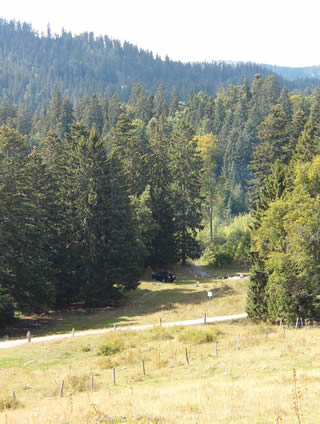 Burgundy (Geantet-Pansiot Chambolle-Musigny 2002
and Armand Rousseau Clos de la Roche 2000), and some very nice
RhŰne wines (Thierry Allemand Cornas Reynard 2001 and Gilles
Barge Condrieu La Solaire 2003). On Saturday we began with a boat
trip across the lake into town, followed by lunch in a very swanky
restaurant. On Sunday it was off to the Jura mountains over the border
in France for an alpine barbecue (left); stunning scenery and
some very nice wine to wash the steaks down with. Then on Monday, the
bravest souls in the party went to Forest Land to climb high in the
trees. We followed this with another good lunch and then a swim in the
spectacular open air pool at Nyon, overlooking the lake. Cliffís
wifeís (Mel) brother and his family joined us for a wild, crazy
barbecue last night, and then today we reluctantly had to return to
earth with a bump. Burgundy (Geantet-Pansiot Chambolle-Musigny 2002
and Armand Rousseau Clos de la Roche 2000), and some very nice
RhŰne wines (Thierry Allemand Cornas Reynard 2001 and Gilles
Barge Condrieu La Solaire 2003). On Saturday we began with a boat
trip across the lake into town, followed by lunch in a very swanky
restaurant. On Sunday it was off to the Jura mountains over the border
in France for an alpine barbecue (left); stunning scenery and
some very nice wine to wash the steaks down with. Then on Monday, the
bravest souls in the party went to Forest Land to climb high in the
trees. We followed this with another good lunch and then a swim in the
spectacular open air pool at Nyon, overlooking the lake. Cliffís
wifeís (Mel) brother and his family joined us for a wild, crazy
barbecue last night, and then today we reluctantly had to return to
earth with a bump.
Quite literally, because the landing at London City
Airport was decidedly dodgy; the pilot aborted the first landing just
after touch down, whacking the power back on and taking off for
another circuit, before landing very heavily at second attempt 10
minutes later. Something about the runway being too shortÖ Geneva is
of course wine country: I managed a short wander through some vines,
which looked in pretty good shape. I also had a chance to drive
Cliffís Land Rover Discovery, which is a fine tank of a 4 ◊
4. Overall, a fund of fine memories from just a few days. People
typically complain about their in-laws; I feel rather lucky that mine
are such a fine bunch of people with lovely kids to boot. And in case
any of my siblings are reading this, be assured that I also feel lucky
to have them!
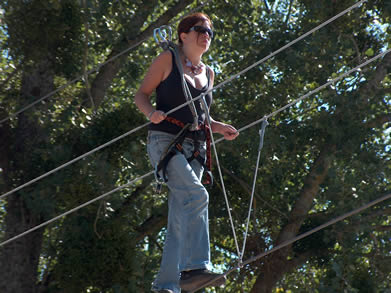 |
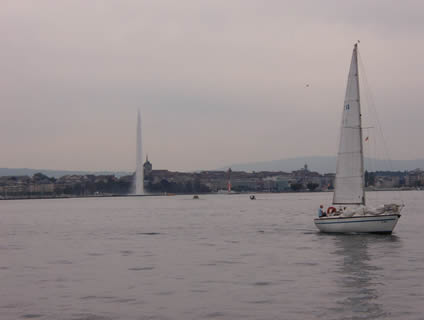
Fiona at 15 metres (left); Geneva from the lake (above) |
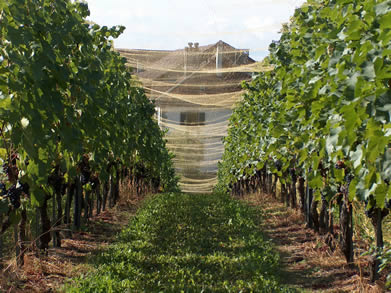 |
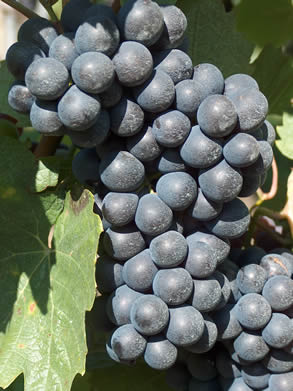 Nets
protecting ripening Pinot Noir (?) grapes in a vineyard in
Commugny Nets
protecting ripening Pinot Noir (?) grapes in a vineyard in
Commugny |
The price of a few days away, however, is an enormous
in box and some deadlines to attend to. I also noticed in Harpers that
there are three letters protesting about my review of David Bird's new
edition of his Understanding wine technology. I stand by the review: I
said that the design of this self-published book was hideous but the
content was sound. Perhaps I wasn't diplomatic enough in the way I
wrote, and I'm sorry that the review upset him and others. But I've
made my mind up already: as soon as I started writing about wine
seriously I realized that there's sometimes a choice to be made
between calling it as you see it and not upsetting people. I'm afraid
that I definitely going to upset some people because I can't operate
any way other than giving my truly held opinion.
Thursday
25th August
Just finished my piece on synaesthesia for The
World of Fine Wine. Itís been fun to write. Synaesthesia is the
rare condition where one sense stimulates another. Most often,
synaesthetes see a colour when prompted by a grapheme (a number,
letter, or word, spoken or written). In one rare case recently
described in the journal Nature,
a 27 year old musician recognizes musical intervals by specific
tastes. What relevance does this have to wine tasting?
In the article I use synaesthesia as a springboard to explore
the way we process flavours in the brain and then how we use language
to describe our perception of wine. While many people deride wine
tasters for their use of figurative language (metaphor, synaesthesia,
metonymy, etc.) there simply isnít any other way for us to convey in
words many important aspects about wine. If you restrict yourself to a
naming of the aromas and flavours present in a sort of analytical way,
then youíll be at a loss when it comes to describing many of the
important aspects of wine such as structure and texture. I argue that
metaphor isnít just a legitimate linguistic tool in wine
description, itís an essential one.
Off
to Geneva tomorrow with the family for a long weekend. We're going to
see Fiona's brother, who's been working there in banking for the last
15 years.
Fiona's sister and her family will also be in attendance. There's lots
to do in the Geneva environs and we're looking forward to it greatly.
We may even enjoy some good Swiss wine.
Tuesday
23rd August
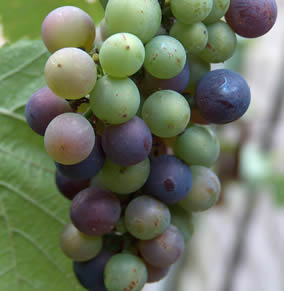 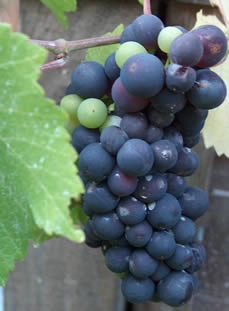
As
regulars here will know, I dabble in growing vines. Viticulture
fascinates me. The vine enthralls me. Of the five varieties I've
grown, Pinot Noir is my favourite, but is also the most difficult
because of its disease susceptibility. I have no idea which clone I
have, but it grows pretty well, as long as I remember to spray it
frequently with sulphur. My Pinot is currently going through veraison,
although some vines are further on than others (see pictures above).
Phoenix, a white grape, is the easiest variety I've tried because it's
disease resistant and no spraying is needed. These are the two I'm
concentrating on, although I do have quite a bit of Bacchus, which
ripens comfortably in our rather pinched growing season.
Had
lunch yesterday with Peter Godden of the Australian Wine Research
Institute (AWRI), arguably the world's top centre for wine science.
Peter is on a three month break, which he's spent in Europe. As well
as running the Industry Services operation for the AWRI (disseminating
good wine science through the Australian wine industry), Peter also
has a small vineyard - one hectare of Nebbiolo vines in the Adelaide
Hills, which eats up a lot of his spare time and all his spare money.
His goal is to make a super-premium Nebbiolo. No wine has yet been
released, and he's been hindered in his efforts by some legal issues
with the landowner who he's leased his vines from. But if the wine
does see the light of day, I'm sure it will be worth looking out
for.
I'm
off to Adelaide, via a sojourn in Singapore, late next month. It's fun
planning a trip like this; the difficulty is what to leave out because
there is so much to see and so many thoroughly interesting people to
meet.
Friday
19th August
Itís that time of year, when every warm day is extra
special, because we donít know how many more we are going to get.
People think of August as the summer month, but if we consider that
the height of summer (in terms of the longest day) is at the end of
June, then late August is equivalent to early May, and September to
April. So there really isnít much summer left. Enough of the weather
rambling. The forecast look set good for Thursday, so we headed off
for another day at the beach. It was another cracking, restful day.
Arriving home late, there was time for a glass of wine. I opted for
the Brown Brothers Moscato 2004, out of curiosity more than anything
else. This is a wine that weighs in at just 5.5% alcohol. Itís
bright, fresh and perfumed with the zippy acidity offsetting the
sweetness perfectly. A sweet, delicate wine. My only misgiving is
Iím not sure when Iíd drink it. If you served it as a dessert
wine, youíd have to choose carefully what you paired it with Ė it
would need to be a fresh, fruit-based dessert. It would work as an
aperitif, but people have got out of the habit of serving sweet wines
at all, and youíd be brave if you gave this to your guests. Still,
it captures in its delicate freshness all the essence of early summer,
and as autumn is beginning to approach, itís nice to have a wine
that can transport us back to that thrilling time of year.
Tuesday
16th August
Iím exhausted after two days spent decorating. Yes,
we bought the house two years ago, and moved in some 20 months ago,
but we still havenít touched one of the reception rooms and our
bedroom, and until Monday we hadnít started with the hallway and
landings. We have now, and Iím knackered. Itís nice, though, to
actually do work that involves more than sitting on my backside in
front of a monitor or laptop screen. I would love to spend three days
a week working on my wine writing (and the associated tasting and
drinking that this involves) and then a couple of days a week doing
something physical. But wait a minute, there are seven days a week.
Wouldn't it be fantastic to have two days a week off! For me at the
moment, no chance.
Talking of physical activity, I lose many calories a
day trying to catch our rabbits. We let them out to roam free and
happy, but then we have to catch them. Rabbits, being rather dull
creatures, donít realize that when their human owners are attempting
to round them up, it is to prevent them being devoured by foxes Ė
for them, itís a matter of life or death to avoid being caught. They
think we want to eat them. Not so. Rabbits are blessed with many
strategies for avoiding capture. But we humans are smarter. Much
smarter. And in the evolutionary hierarchy, smartness trumps just
about everything else. So the rabbits are caught, no doubt relieved to
find out that their capture is not followed by demise by consumption,
and I can relax.
Relaxing this evening is in the form of three wines
(although youíll be glad to hear that all three are not consumed
during the course of the evening Ė this would be needlessly
excessive. One of the benefits of having a national column is that one
is deluged by samples, and part of an eveningís work consists of
selecting a few to open and tasteÖ). First, to complement the mild,
still summerís evening weíre enjoying here in Feltham, the Cheapskate
Skinflint Rosť 2004 from California. This is another wine from
Clark Smith, who I mentioned earlier. Itís a saignťe wine from his
Cheapskate Miser, and although it (refreshingly) doesnít take itself
too seriously, itís a fabulous, brilliantly balanced rosť, with
lots of fresh fruit and a gently herby tang. Dangerously easy to
drink, like most good rosťs. The second wine is Calatrasiís
Terre Di Genestre Nero díAvola 2003. This came back with me from
the Sicily trip mentioned below. In the tasting it showed
fantastically oaky. In fact, it was close to undrinkable. However, a
second bottle opened then showed much better. It was from the same
batch. How can a wine be massively overoaked from one bottle, and OK
from a second? I donít know. This time, itís not overoaked,
although the oak is prominent. Itís definitely a bit oaky, but this
tarry, roasted coffee oak is a complement to the ripe fruit in a way
that the rather sickly vanilla and coconut oak in the blinded bottle
in Sicily wasnít. A rather commercial style, but a good wine;
perhaps even better if Tamra can lose some of the new barrels and let
the fruit show through. Thirdly, I opened a McGuigan Estate
Limestone Coast Shiraz 2004. The dominant feature here is the
intense blackcurranty fruit. Itís an impressive forward sort of red
with some class, and the oak is very much in the background,
contributing a spicy overlay that works well. This is currently on
offer in Sainsbury at £3.99, which is a bargain considering that I
reckon this is fair-ish value at the list price of £7.99. For £4
it's a bit of a no-brainer.
Friday
12th August
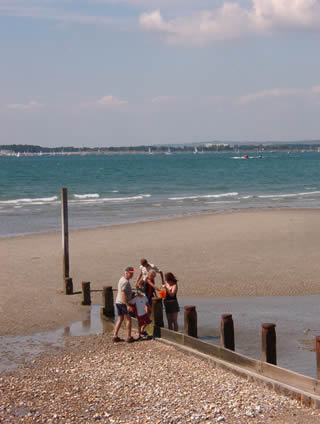 Spent a near-perfect day yesterday at
the seaside, with two other families we're friends with. We set
off at 6.30 am, hitting the beach just after 8 (such an early start
sounds crazy, but it means we miss the hideous traffic around London
from 7.30-9 am). We went to West Wittering, which is a beautiful beach not far from
Chichester in West Sussex. It's unspoiled, with no amusement
arcades or beachfront tack - the only signs of commercial activity are
a small tea shop and cafe. We played beach cricket, fished for
crabs and shrimps, sunbathed, ate a large picnic, had afternoon tea,
paddled and even swam. In all we spent 10 hours on the beach, and it
didn't seem too long. No wine, just a couple of cold beers from the
icebox. Spent a near-perfect day yesterday at
the seaside, with two other families we're friends with. We set
off at 6.30 am, hitting the beach just after 8 (such an early start
sounds crazy, but it means we miss the hideous traffic around London
from 7.30-9 am). We went to West Wittering, which is a beautiful beach not far from
Chichester in West Sussex. It's unspoiled, with no amusement
arcades or beachfront tack - the only signs of commercial activity are
a small tea shop and cafe. We played beach cricket, fished for
crabs and shrimps, sunbathed, ate a large picnic, had afternoon tea,
paddled and even swam. In all we spent 10 hours on the beach, and it
didn't seem too long. No wine, just a couple of cold beers from the
icebox.
Got
home about 9.30 pm, and had a glass of the Cheapskate
Miser 2003. It's a low budget Californian red made by Clark
Smith's Winesmith wines. Clark is the guy behind California's
Vinovation, a company who offer reverse osmosis, microoxygenation and
allied services for winemakers. I'll be writing more about the
Winesmith wines in the next few weeks because they are hugely
interesting, and the two Cheapskate wines I've tried so far have been
fantastic - some of the best value wines I've ever tried. As well as
budget wines that offer remarkable value, there are some high end
wines, including a Faux Chablis and a serious Cabernet that retails
for more than $100. Clark sent me a bottle of this high-end Cab along
with the same wine vinified by conventional methods. I look forward to
comparing them.
Thursday
11th August
Some people claim that wine preferences are entirely subjective,
and that there is no such thing as good or bad wine - it's all a
question of what we 'like'. We could argue about this for a long time,
but let me get practical for a moment. Sutter Home White Zinfandel
is a bad wine. A pale salmon pink, it's medium sweet with 9.5%
alcohol. Nothing inherently wrong with that, but there is with the
taste. To my palate, it has a nasty chemical-like edge. I approached
this wine with an open mind, and I don't think it's very nice. We've
had some teenagers stay over the last few days - my niece and two of
her pals, coming up from Devon to visit the big city. It's been fun
having them stay. They're 16, and so I offered them a glass of the
Sutter Home vileness, and one - the boy - accepted. He took a glass
and filled it brim full (these are big glasses that take the best part
of half a bottle, if you brim them which clearly you aren't meant to
do). We went to bed and left the teenagers talking until the early
hours - teenagers love to talk, they don't do much else, apart from
watch big brother - and the next morning the bottle was empty.
So someone out there likes Sutter Home White Zinfandel a good
deal.
Monday
8th August
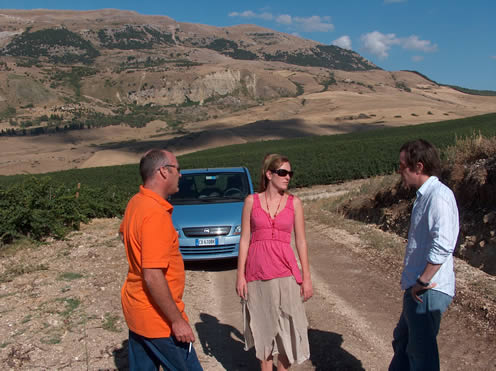
Sean
Howe, Tamra Washington and Sam Harrop MW, in Sicily
I've been thinking more about what Calatrasi are up to in Sicily,
spurred on by the thought that this southern island has an area under
vine similar to that of Australia. Yet while we've all drunk loads of
Australian wine, we hardly ever drink Sicilian wine. Look at the
Sicilian wines in the UK marketplace: a few very ordinary supermarket
own-label efforts, and then the likes of Cusumano and Planeta (I'm not
terrribly impressed with either, to be honest, and the Planeta wines
are very expensive for what they are). Yet the potential is certainly
there. The problem seems to be with the competence and attitude of the
growers. Watching the European wine industries trying to face the
demands of the modern marketplace is a painful experience. It's a
bit like a gritty British film, where somewhere oop north a manual
industry goes belly-up, leaving emotionally inadequate and mentally
challenged men who've grown up with the idea that they'd have a job
for life to find a new vocation. Brassed Off meets The Full
Monty. The stage most of the European wine industry is currently
at seems to be one of denial, thinking that if they just carry on the
way they have been things will be alright. Sean Howe was telling me of
his trips to Puglia to source grapes. He visits literally hundreds of
vineyards to find just a few to buy from. He told me about one
fantastic old vine vineyard that would have been perfect, but because
the grower won't spray the mildew problem means that come harvest the
grapes will be unsaleable. You get the impression that companies such
as Calatrasi, who want to make the sorts of wines the markets want,
have to fight very hard against the system in order to do it.
Then,
when you've made the wine, you have to sell it. No consumers in the UK
know anything about Sicilian wines. Brand Sicily needs to be built:
people have to become aware of Sicily, and Sicily needs a coherent,
interesting story to tell about its wines. Nero d'Avola and Cataratto
could be selling points. The Italian Trade Commission isn't doing
much, so I suggested that a group of private wineries - all with the
goal of making really good wines - should get together in a joint
marketing effort, just as has occurred with the Douro winemakers in
Portugal. They could hold a joint press tasting in London, for
example. My friends at Calatrasi just hooted. Getting Sicilian
producers to work together? It's never going to happen.
Previous entries
Back to top |